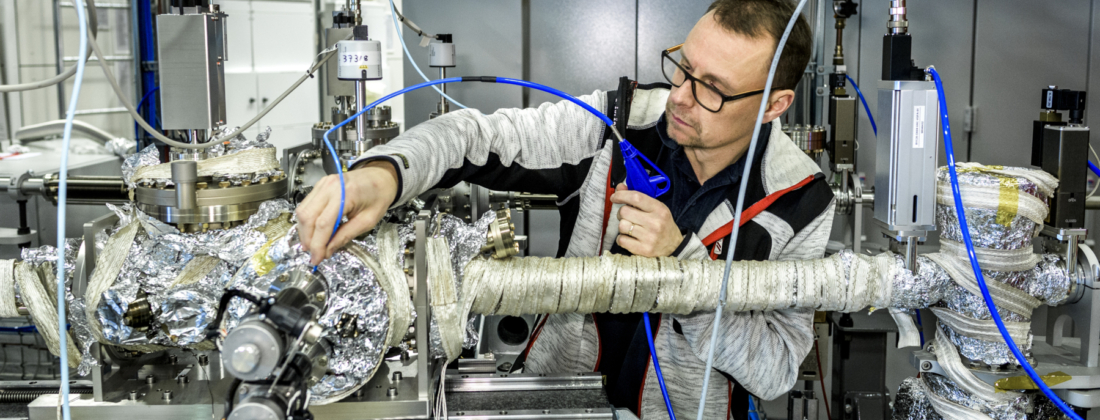Some grand common challenges in certain fields of science have motivated the user community and funding bodies from neighboring countries to develop projects aiming at the design and construction of new beamlines at MAX IV. Such efforts significantly impact the development of the facility and once brought to realisation serve a broad scientific audience through open calls. MAX IV extremely values these contributions and welcomes interest to provide input on possible future advancements.
The financing and construction of the FinEstBeAMS beamline (Finnish-Estonian Beamline for Atmospheric and Materials Sciences) at MAX IV is the result of support for synchrotron-based research in Finland and Estonia at a national level. The Estonian side of the FinEstBeAMS collaboration, headed by Ergo Nõmmiste from the University of Tartu, obtained funding from the European Union (through the European Regional Development Fund) for the project “Estonian beamline to MAX-IV synchrotron”. Marko Huttula from the University of Oulu coordinated the preparation of three Finnish Research Infrastructure funding applications that secured funding from the Academy of Finland. University of Oulu, University of Turku, and Tampere University of Technology have been the main Finnish partners in this project.
Marco Kirm from the University of Tartu became the principal Estonian spokesperson of FinEstBeAMS in 2019. Marko Huttula has been the general coordinator of research activities at FinEstBeAMS. The Estonian and Finnish partners continue to invest in FinEstBeAMS after its completion. The researchers at the Institute of Physics of the University of Tartu have recently obtained a grant that will be partly used for instrumentation of FinEstBeAMS, including the acquisition of a third grating for its monochromator.
Danish involvement at MAX-lab has a long and successful history with Danish researchers being frequent guests at many beamlines and covering a wide range of scientific disciplines. The close proximity to Denmark and effective collaboration with MAX IV provided a setting for outstanding science. The DanMAX consortium was formed in 2009 involving Aarhus University (AU), Technical University of Denmark (DTU), and Copenhagen University (KU). The first step towards realizing a beamline dedicated to studying “real materials under real conditions in real time” was an infrastructure grant of 35 million DKK from the Danish Ministry of Research. This led to subsequent investments from the three universities, the Capital and Central Denmark Regions and MAX IV Laboratory, and in 2015 an agreement was reached to initialize the DanMAX project. The DanMAX user consortium combines 48 staff members from five major Danish universities and 17 industrial companies. The academic partners of the DanMAX consortium are AU, DTU, KU, University of Southern Denmark, Roskilde University, and Aalborg University. The persons leading the initiative on the Danish side are Bo Brummersted Iversen (AU), and Kirsten Marie Ørnsbjerg Jensen (KU), and were Henning Friis Poulsen (DTU).
ForMAX is funded by the Knut and Alice Wallenberg Foundation and Swedish industry via Treesearch – a national platform for research on new materials and speciality chemicals from forest raw material. The beamline is accessible for both Treesearch members (50%) and general users (50%) through the MAX IV user program.
The MicroMAX project is funded by Novo Nordisk Fonden (https://novonordiskfonden.dk/). The application was prepared by MAX IV Laboratory and leading scientists from Aarhus University, Technical University of Denmark (DTU), University of Copenhagen, University of Gothenburg and Lund University. The proposal was supported at these universities by the leadership and a large number of scientists, by other research centers funded by Novo Nordisk Fonden and by other large scale research infrastructures in the region of relevance for structural biology.
The grant funds both the construction of the macromolecular crystallography beamline MicroMAX and ten years of operation of the beamline, but also an Education and Training Initiative aiming at current and future users from the structural biology communities in academia and industry, but also targeting the general public. The goal of this initiative is to make the new techniques and methods at MicroMAX available to the general user community and not only to experts in for example serial crystallography.
The MicroMAX projects builds on a long history of close collaborations within the Swedish and Danish structural biology communities and in particular collaborations of funding, realizing and operating macromolecular crystallography facilities at MAX-lab.
The construction of part of Veritas B was made possible during 2016 – 2017 by support received from Prof Anders Nilsson’s group at Stockholm University (SU).
The group was building mobile endstations for high pressure X-ray photoelectron spectrometry and X-ray emission spectroscopy, and provided 2.5 MSEK for the completion of the branch. VERITAS B is used for the two SU endstations and other strategic development projects.
The MAX IV beamline portfolio offers experimental capabilities relevant to various materials sciences that fit into the Wallenberg Initiative Materials Science for Sustainability (WISE) Initiative focus areas. In April 2023, the report “MAX IV and WISE – Summary of Existing Capabilities” was released, presenting relevant examples of scientific experiments that either have been done or can be done with the currently available techniques, and how they align with the WISE initiative.
The document can be downloaded here.
